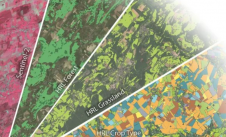BRIC
The new buzzword in the international economy is BRIC, an acronym from the first letter of four countries in different corners of the world; Brazil, Russia, India and China. Why in international economics is it all about these four? Because they are the most swiftly developing local economies in the world. The common factor is that they have all for years been showing growth in double figures, and for the foreseeable future there seems no stopping them. Of course, a closer look at the four reveals some differences between them as well. And the differences become even more striking when you look at these economies through geomatics glasses.
Let’s start with Brazil and Russia, the B and R in the acronym. In many aspects two totally different countries, but with a lot of similarities as well. Both have an economic structure laid down years ago and heavily dependent on agriculture and industry. And for both countries its language, respectively Portuguese and Russian, creates something of a barrier between it and the rest of world. Latin America, including Brazil, has developed its own economy, independent for a great part from the United States and Europe, excepting the Iberian Peninsula. Russia was secluded from the western world for decades by the Iron Curtain. Now both Brazil and Russia are more open it looks as if international manufacturers in our field are finding an easy way into new distributor- and dealerships. These countries need (geomatics) products from other parts of the world to provide support for immense geo-referenced data consumption underpinning the development of large infrastructure and other projects. Entire surface areas are being covered in tarmac, houses, offices etc. Local and even regional economies are gaining world significance through their sheer vast size.
To me the economies of India and China seem to have an important something distinguishing them from those of Russia and Brazil. In the eastern economies of I and C developments in geomatics represent much more of an export than an import factor. India attracts more than 25% of international investment in research & development and subsequently exports much of the knowledge accrued, to the benefit of its own economy. And whereas China is still known to the masses as the country that can produce almost everything imaginable, its abilities, especially in coastal areas, are rapidly heading towards technology development as well. In the near future China could easily become a great competitor for India in attracting those R&D funds.
Although there are distinctive differences between Brazil, Russia, India and China, one thing is sure; all four economies will have a major impact on geomatics. If not in importing large quantities of products from the rest of the world and thus boosting production, then in exporting new techniques, hard and software to that same rest of the world. And therefore shaping the change.
Make your inbox more interesting.Add some geo.
Keep abreast of news, developments and technological advancement in the geomatics industry.
Sign up for free
























